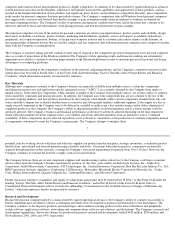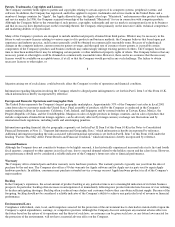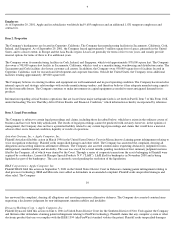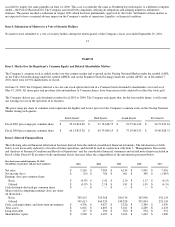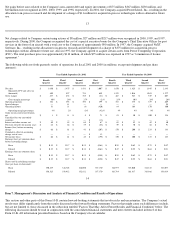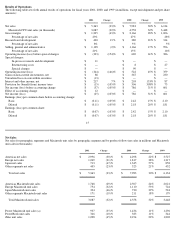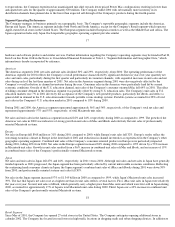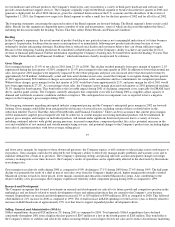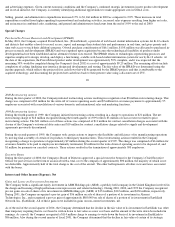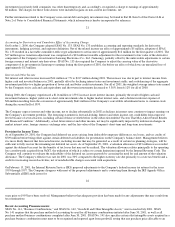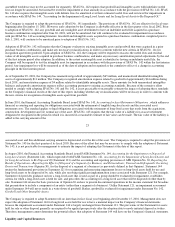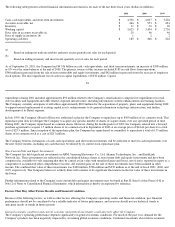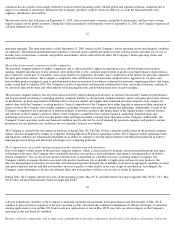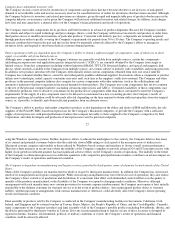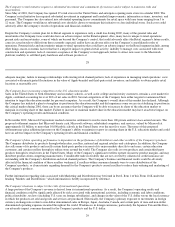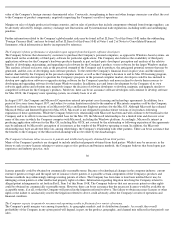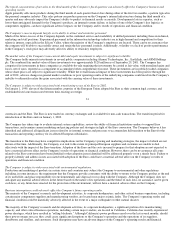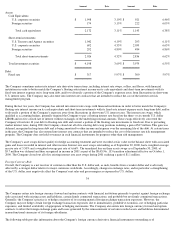Apple 2001 Annual Report Download - page 17
Download and view the complete annual report
Please find page 17 of the 2001 Apple annual report below. You can navigate through the pages in the report by either clicking on the pages listed below, or by using the keyword search tool below to find specific information within the annual report.
and advertising expenses. Given current economic conditions and the Company's continued strategic investments in new product development
and its retail initiative, the Company is currently identifying additional opportunities to make appropriate cuts in SG&A costs.
Selling, general, and administrative expenditures increased 17% to $1,166 million in 2000 as compared to 1999. These increases in total
expenditures resulted from higher spending for promotional and marketing activities, increased sales expenses resulting from higher net sales,
and an increase in combined sales, marketing, and general and administrative headcount from the end of 1999 to the end of 2000.
Special Charges
Purchased In
-Process Research and Development (IPR&D)
In May 2001, the Company acquired PowerSchool, Inc. (PowerSchool), a provider of web-based student information systems for K-12 schools
and districts that enables schools to record, access, report, and manage their student data and performance in real-time, and gives parents real-
time web access to track their children's progress. Of total purchase consideration of $66.1 million, $10.8 million was allocated to purchased in-
process research and development (IPR&D) and was expensed upon acquisition because the technological feasibility of products under
development had not been established and no alternative future uses existed. The IPR&D relates to technologies representing processes and
expertise employed to design, develop, and deploy a functioning, scalable web-based student information system for use by K-12 schools. At
the date of the acquisition, the PowerSchool product under development was approximately 50% complete, and it was expected that the
remaining 50% would be completed during the Company's fiscal 2002 at a cost of approximately $9.25 million. The remaining efforts include
completion of coding, finalizing user interface design and development, and testing. The fair value of the IPR&D was determined using the
income approach, which reflects the projected free cash flows that will be generated by the IPR&D projects and that is attributable to the
acquired technology, and discounting the projected net cash flows back to their present value using a discount rate of 25%.
20
2000 Restructuring Actions
During the first quarter of 2000, the Company initiated restructuring actions resulting in recognition of an $8 million restructuring charge. This
charge was comprised of $3 million for the write-off of various operating assets and $5 million for severance payments to approximately 95
employees associated with consolidation of various domestic and international sales and marketing functions.
1999 Restructuring Actions
During the fourth quarter of 1999, the Company initiated restructuring actions resulting in a charge to operations of $21 million. The net
restructuring charge of $18 million recognized during the fourth quarter of 1999 reflects $3 million of excess reserves related to prior
restructuring actions. The $21 million cost of these actions was comprised of $11 million for contract cancellation charges associated with the
closure of the Company's outsourced data center and $10 million for contract cancellation charges related to supply and development
agreements previously discontinued.
During the second quarter of 1999, the Company took certain actions to improve the flexibility and efficiency of its manufacturing operations
by moving final assembly of certain of its products to third-party manufacturers. These restructuring actions resulted in the Company
recognizing a charge to operations of approximately $9 million during the second quarter of 1999. The charge was comprised of $6 million for
severance benefits to be paid to employees involuntarily terminated, $2 million for the write-down of operating assets to be disposed of, and
$1 million for payments on canceled contracts. These actions resulted in the termination of approximately 580 employees.
Executive Bonus
During the first quarter of 2000, the Company's Board of Directors approved a special executive bonus for the Company's Chief Executive
Officer for past services in the form of an aircraft with a total cost to the company of approximately $90 million, the majority of which is not
tax deductible. Approximately half of the total charge is the cost of the aircraft. The other half represents all other costs and taxes associated
with the bonus.
Interest and Other Income (Expense), Net
Gains and Losses on Non-current Investments
The Company holds a significant equity investment in ARM Holdings plc (ARM), a publicly held company in the United Kingdom involved in
the design and licensing of high performance microprocessors and related technology. During 2001, 2000, and 1999 the Company recognized
pre-tax gains on sale of shares of its investment in ARM Holdings plc (ARM) of $174 million, $367 million, and $230 million, respectively.
During 2001, the Company recognized a pre-tax gain of $36 million on sale of shares of a portion of its investment in Akamai
Technologies, Inc., and recognized a pre-tax gain of approximately $800,000 on sale of shares of a portion of its investment in EarthLink
Network, Inc. (EarthLink). All of these gains were included in gains on non
-current investments, net.
As of the end of the second quarter of 2001, the Company determined that the decline in the fair value of its investment in EarthLink was other
than temporary requiring that its cost basis be written down to fair value as a new cost basis and the amount of the write down be included in
earnings. As a result, the Company recognized a $114 million charge to earnings to write down the basis of its investment in EarthLink to
$86 million. Also during the second quarter of fiscal 2001, the Company determined that the decline in fair value of certain of its strategic


